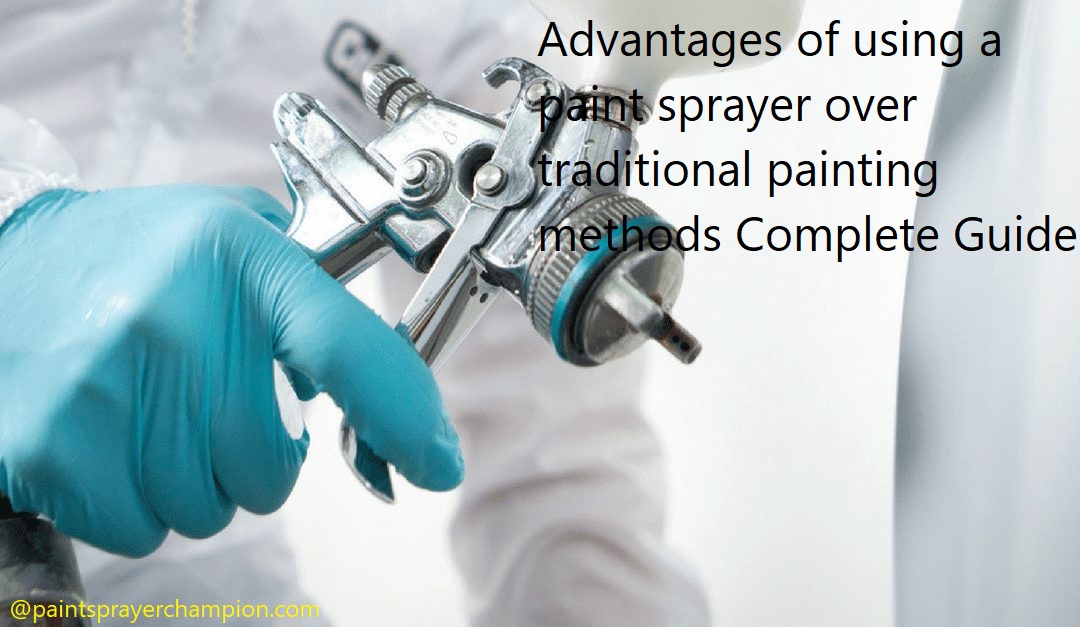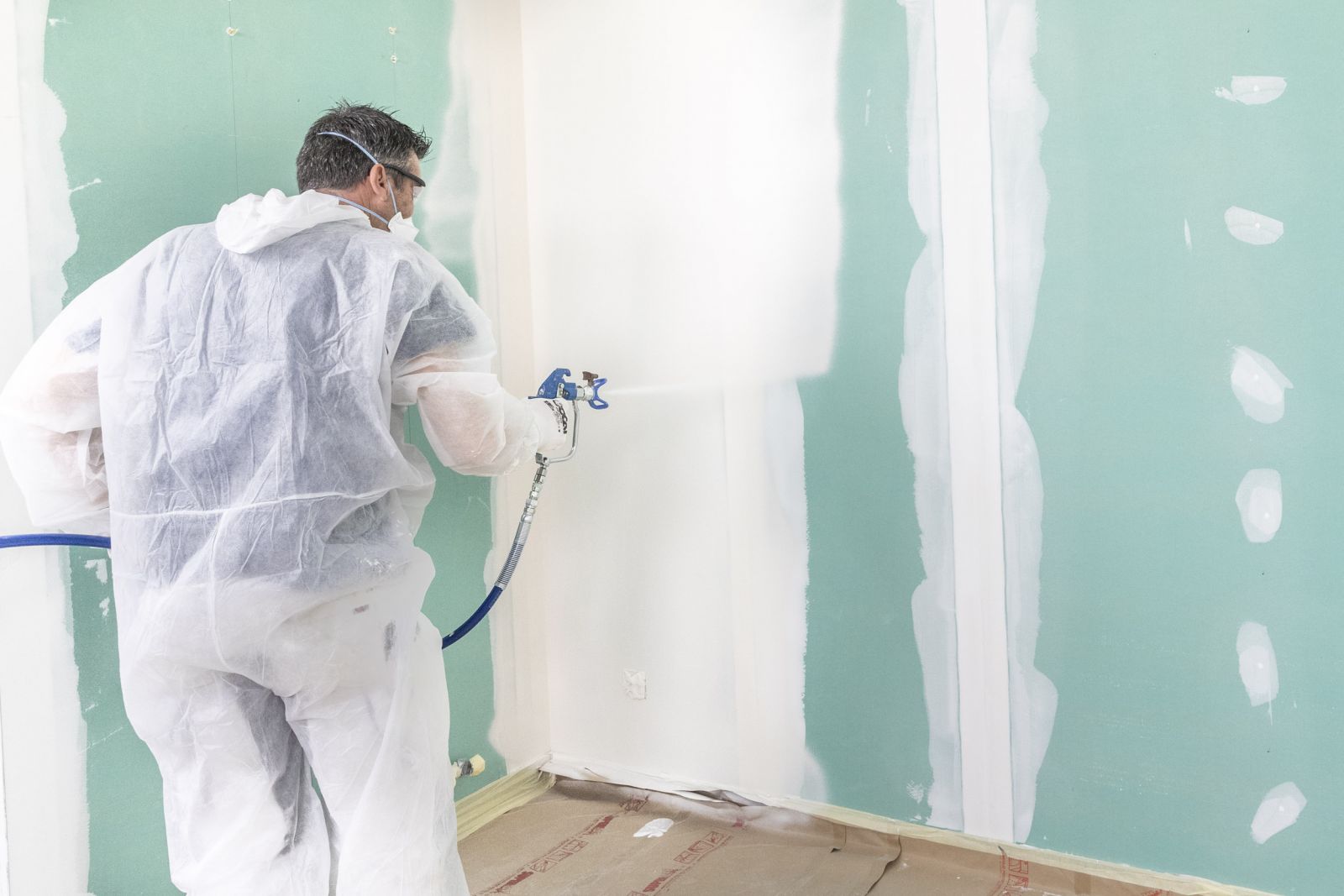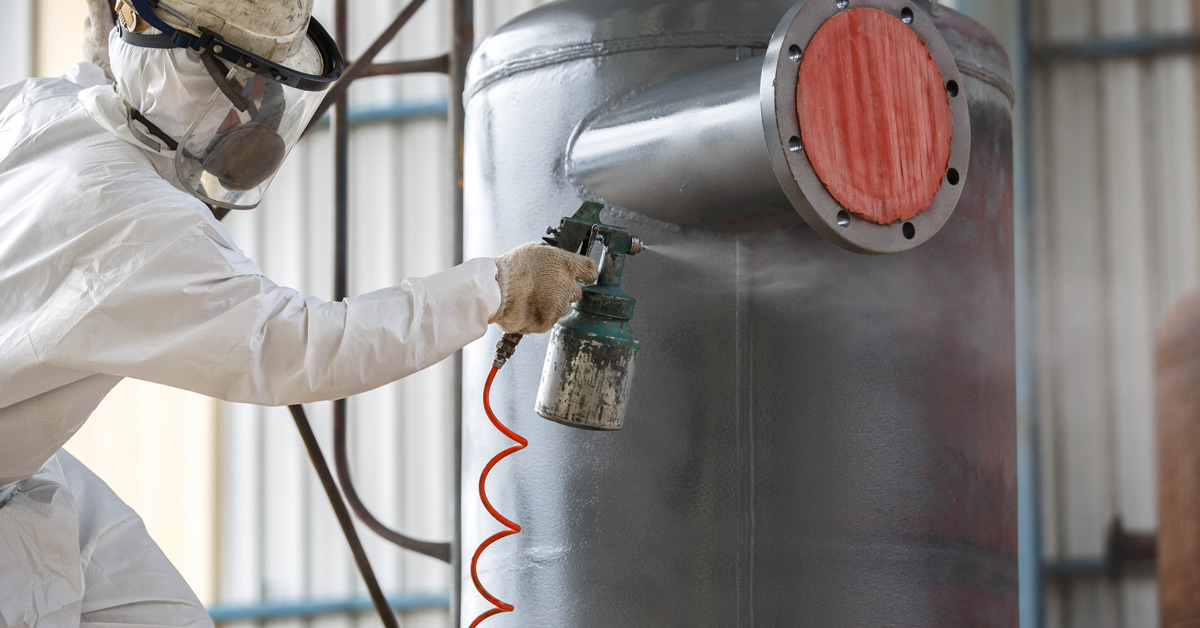Are you looking for a quicker way to paint your home or property? Paint sprayers are the answer. Not only are they faster than traditional painting methods, but they also provide better coverage and an even coat.
Read on to discover the many advantages of using a paint sprayer instead!
Paint sprayers are quickly becoming a popular choice for ambitious do-it-yourself projects. Sprayer technology has come a long way in recent years, making them relatively inexpensive, easy to use and efficient. Paint sprayers allow you to evenly coat wide areas quickly with minimum effort. They also reduce waste and drastically improve accuracy in tight corners and small details. These advantages make paint sprayers an ideal choice for anyone looking to give their projects a professional look or simply get the job done faster.
Paint spraying has many unique benefits that traditional brush or roller techniques simply can’t match; these include:
- Reduced overspray due to precise control of water/paint mix
- Excellent coverage in difficult to reach areas
- Time savings compared with traditional methods
- Reduced waste through precise control of pressure and coverage
- Capable of spraying heavy objects with less fatigue than rolling or brushing
- Minimal drying time due to thinner film application
- Ability to add small amounts of water for a smoother application
Explanation of the topic
When it comes to painting, there are a variety of tools and techniques available to suit different projects. For example, brush and roller pressures are common for walls as well as roller pressure for ceilings. If you’re looking for a fast, efficient and even painting application however then using a paint sprayer could be the best option.
Paint sprayers utilize compressed air from an air compressor to pressurize and atomize the paint before it is applied to the surface. This results in a more uniform finish across large surfaces because the paint travels in finer droplets than when using brush or roller applications. When used correctly, paint sprayers can deliver an even coat that is quicker than traditional painting methods which can save time and money on larger jobs.
The ability of a paint sprayer to achieve uniform coverage also means that it is easier to achieve straight line finishes as well as getting into tight corners or difficult angles with precision and ease. As with applying any kind of paint work, preparation is key; this includes proper masking up in order to avoid any overspray during application of the finish coating.
Not only does using a paint sprayer help create better coverage than other painting methods, but also it has numerous health benefits too; consider reducing contact with airborne particles when compared with traditional brushing or rolling methods that can cause respiratory irritation due to inhalation of dust particles created by those processes. In addition, there will be less contact with potentially hazardous chemicals such as paints worn off when lifting wet brushes or rollers which can cause skin irritations depending on which type of protective gear is used while handling them. All these factors added up make using a paint sprayer one of the safest ways possible when tackling any kind of large surface area work such as house exteriors or industrial surfaces like shipping containers amongst others due to its portability given most products available today offer wheeled versions for maneuverability purposes.

Importance of the topic
The importance of this topic lies in the various advantages gained from using a paint sprayer compared to traditional painting methods. Paint sprayers significantly reduce painting time as they allow for rapid application. This means less disruption within a work space and much shorter project completion times.
Moreover, with a paint sprayer, painters can achieve an even coat over many fluctuating surfaces, ensuring that projects have the best possible finish. For example, due to their uniformness, paint sprayers are especially well-suited for large exterior and interior walls that require coverage of varying degrees of intricacy. As such, it is an invaluable tool for commercial painters as well as home DIY-ers.
Furthermore, paint sprayers are incredibly efficient with minimal wastage and cleanup effort required after use. Put simply, using a paint sprayer can save you considerable amounts of both time and money with regards to painting projects of any kind or scale.
Brief overview of the advantages of using a paint sprayer
Using a paint sprayer to apply paint offers a number of advantages over traditional brush or roller painting methods. Paint sprayers are capable of spraying a wider variety of paints, stains and finishes than traditional painting tools, such as latex and oil enamel. The even spread of solutions with a paint sprayer is especially useful for large surfaces needing to be covered quickly and evenly with few brushstrokes. A correctly adjusted sprayer will leave a uniform finish that is both durable and smoother than when applying by hand.
In addition, paint sprayers dramatically reduce application time over hand-painting, often cutting hours out of projects that would otherwise have taken two or three times longer. The convenience and speed allows projects to be finished more quickly with less worry about inconsistent results from multiple layers of coating due to overlapping dried areas or dripping centers when using cans or rollers. Plus, most professional painters report fewer problems related to painter’s fatigue when using an airless paint sprayer, allowing them to do their job faster without the need for breaks away from the task at hand.
Advantages of using a paint sprayer
Using a paint sprayer instead of traditional painting methods can provide several advantages. It can save you time, help you achieve a professional-looking finish, and reduce the amount of paint wastage.
Time Savings: A paint sprayer will allow you to get the job done faster than traditional methods like rollers and brushes. Paint sprayers produce an even coating of paint with no streaks or lap lines that reduces the need for multiple coats. This results in faster painting and touch ups when needed, allowing you to complete entire projects in no time at all.
Professional Finish: Paint sprayers give your walls an even finish with no brush strokes, drips or runs that can make even the most advanced painter’s happy with their project results. The result is a professional-looking finish for your home that lasts for years with minimal effort on your part.
Paint Conservation: Oftentimes, when using traditional painting methods like brushes and rollers, a lot of paint goes to waste as it’s spread unevenly over surfaces or is lost due to overspray and dripping onto surfaces below or around them. Paint sprayers allow you to use less paint while applying an even coat without the need for multiple coats, resulting in less wasted materials and fewer cans used overall which saves you money as well as time!
Time-saving
One of the major advantages of using a paint sprayer over traditional painting methods is that it will save you time. With a standard brush or roller, you’ll have to apply multiple coats and wait for each coat to dry completely before starting the next one. With a paint sprayer, however, you can get your project done quickly and all in one go.
The even application means that fewer coats are needed, which accelerates your timeline considerably. Paint sprayers are also generally faster to use than brushes and rollers since they don’t require much force or effort. You can simply move the wand back and forth over the surface of your project, letting the machine do most of the work for you.
Even coverage
When painting with a brush and roller, there are several areas that can be hard to reach, like details such as window frames and trims. Even with the expertise of a professional painter, it is impossible to achieve an even finish with conventional painting methods. On the other hand , when you use a paint sprayer, you get perfect coverage due to the atomization process which evenly distributes the paint or stain.
Paint sprayers produce an even finish across all surfaces and make sure that no area of your project is left uncovered. Plus, you don’t have to worry about dealing with thick or thin jackets as paint sprayers disperse an equal amount of coating on all areas.
Versatility
Paint sprayers offer versatility in terms of the types of materials and surfaces that can be painted. Whether it is a latex, oil-based, lacquer, enamel or water-based finish, a paint sprayer can achieve an even coat. This makes it especially convenient for users who need to switch between various types of finishes for different projects.
Paint sprayers are capable of painting objects with intricate shapes and hard to reach areas, delivering superior results in a fraction of the time needed for brush or roller painting. In addition, paint surface imperfections resulting from overlapping brush strokes can easily be avoided using a paint sprayer.

Professional finish
Using a paint sprayer can give you a professional-grade finish that acts as a barrier against moisture and provides years of protection from dirt and harsh weather conditions. Unlike other methods, the sprayer does not leave any brush or roller strokes behind and allows for even coverage across all surfaces. Additionally, when using higher-quality products, the finish may be even smoother compared to brushes or rollers. The resulting paint job will last longer than with traditional methods and you’ll need to touch up any chips less often.
You’ll also be able to access tight spaces or difficult positions with ease. If the job requires intricate brushwork, then you may require a sprayer in order to achieve the desired look.
How to use a paint sprayer
Using a paint sprayer to finish a surface area is much quicker and easier than traditional methods. This streamlined process can save time and money, providing a professional look for both indoor and outdoor projects. Before you start, it’s essential that you understand all the steps required to properly use your paint sprayer.
Firstly, prepare the area that needs to be painted. Make sure it is clean and dust-free before applying any primer or paint with a sprayer. Once the area has been cleaned, apply the primer coat evenly onto the surface area, working from top to bottom while spraying in an even direction and distance away from the object. After allowing adequate drying time (approximately 12-24 hours), you can move onto adding several layers of paint in order to achieve an even coverage across the entire surface area. These additional layers of paint will also require adequate drying time between each coat (approx 24 hours).
Finally, once all coats have been applied, add a finishing transparent sealant after proper drying time has been allowed. A clear sealant helps protect surfaces and ensure optimal results from your painting project in terms of longevity and color vibrancy on both indoor/outdoor surfaces .
With these tips in mind for using your paint sprayers correctly, you should be able to complete your painting project quickly and efficiently with beautiful results!
Preparing the paint
A paint sprayer saves time when it comes to preparing the paint for application. Using a traditional brush and roller requires carefully measuring the paint and stirring it in order to achieve an even consistency. Spraying the paint eliminates this step as you can use pre-mixed paint as well as paint mixes that are too thick to be used with brushes and rollers.
Additionally, there is no need to tint primer or putty in order to achieve the right color before painting; instead, the sprayer can be adjusted to get the ideal tone while painting. This time-savings means that you’ll be finish your project sooner than with traditional methods!
Preparing the surface
Preparing the surface for painting is one of the most important steps to ensure a lasting paint job. Whether you’re using a paint sprayer or traditional painting methods, proper surface preparation will help ensure a successful outcome.
When using a paint sprayer, the surfaces should be properly cleaned before application. This will help ensure that the paint adheres properly. It is also important to inspect the surfaces before painting and make sure they are in good condition and not showing signs of damage such as peeling, cracking or flaking paint. If necessary, these areas should be repaired and caulked before beginning the painting process.
It is also important to take into account any material that may need to be removed from the area prior to painting in order to protect it from overspray and possible damage from interior chemicals in paints. For example, items such as wallpaper or fabric should be removed from areas where you are planning on using a paint sprayer so that they don’t become discolored by overspray. In addition, items such as exterior windowsills or decorative masonry should also be covered up or masked off with tape for protection as well. Once all prep work has been completed you can then move onto step 3: prepping your room for spraying!
Assembling the paint sprayer
Before beginning any painting job, a paint sprayer needs to be properly assembled. Set up your sprayer according to the manufacturer’s instructions. Make sure all components are tightly attached and that no air is leaking from the hose connections. Attach any necessary additional accessories such as filters, viscosity or pressure measuring devices or extra hoses or lighting needed for large projects.
Test the unit’s functionality with either a pressurized air source or an electrical outlet depending on the type of sprayer being used. Clear the unit of any foreign matter, such as dirt or debris, before using it for painting and make sure to review safety precautions and usage guidelines included with your specific machine before you begin spraying paint.
Conclusion
To summarize, paint sprayers are more efficient and offer a smoother finish than the traditional brush and roller method. Plus, because they create less overspray and can often be used with a variety of paints and materials, they cost much less to use in the long run. For those looking to get great results on their next painting project, investing in a quality paint sprayer may be an excellent investment decision.
In addition, using a paint sprayer is often easier than using traditional painting methods since there is less preparation required. When using brushes and rollers, preparing the area for painting often takes considerable time as you must tape off all areas that you do not want to be painted. With a paint sprayer, you are able to get started almost immediately without worrying about any such preparations. The results that can be achieved by using a paint sprayer are also generally higher quality than what you can achieve with brush or roller methods owing to the even coating that remains achievable with the use of such technology.
Finally, it’s important to make sure that you choose the right paint sprayer for your needs as there are many different models available which offer varying degrees of portability and power settings which may influence your choice depending on your project goals and planned usage frequency.
FAQ’S
What are the advantages of a paint sprayer?
Paint sprayers offer a faster and more efficient way to apply paint, can produce a smoother finish, and can also help save paint by reducing overspray and waste.
What are the advantages of using an electrostatic sprayer over traditional paint spraying?
Electrostatic sprayers charge the paint particles, allowing them to adhere to surfaces more effectively and evenly, resulting in less waste and overspray, better coverage, and faster application.
What are the advantages of spraying method?
Spraying allows for a more even and consistent application of paint, especially on large or complex surfaces, and can save time compared to using a brush or roller.
What is the benefit of spraying instead of brush when painting?
Spraying can provide a smoother and more even finish, with fewer brush or roller marks, and is typically faster for large areas.
What are 5 uses of sprayer?
Sprayers can be used for painting, staining, varnishing, disinfecting, and watering plants.
What are the advantages and disadvantages of using power sprayer?
Advantages of power sprayers include faster application, more even coverage, and the ability to reach difficult areas, but they can be noisy, require more preparation and cleanup, and may cause overspray.
What is the difference between an electrostatic sprayer and a regular sprayer?
Electrostatic sprayers charge the paint particles, allowing them to adhere more effectively and evenly to surfaces, while regular sprayers rely on air pressure to atomize the paint.
What is the primary advantage of power sprayers?
The primary advantage of power sprayers is their ability to apply paint quickly and evenly over large areas or difficult-to-reach surfaces.
Is spraying better than painting?
Spraying can be better than traditional painting methods for certain applications, such as large or complex surfaces, but may not be necessary or cost-effective for smaller or simpler projects.
Is spray paint better than regular paint?
Spray paint can offer convenience and faster application, but may not provide the same level of durability or coverage as traditional paint. The choice between the two depends on the specific project requirements and personal preferences.
See Also:
- Best indoor paint sprayer
- Best sprayer for latex paint
- Best professional paint sprayer
- Best paint sprayer
- Best paint sprayer under $100



